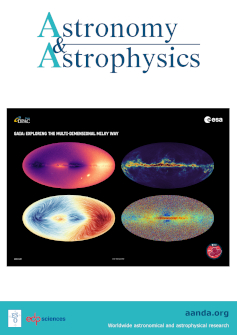Experimental confirmation of barrierless reactions between HeH+ and deuterium atoms suggests a lower abundance of the first molecules at very high redshifts
IF 5.4
2区 物理与天体物理
Q1 ASTRONOMY & ASTROPHYSICS
引用次数: 0
Abstract
The HeH+ ion was the first molecule to form in the early Universe, and its comparatively large dipole moment renders it a potential coolant, relevant during the epoch of first star formation. The main destruction mechanisms under primordial conditions are recombination with free electrons and chemical reactions with hydrogen atoms. The latter process was believed to be slow at low temperatures, owing to a barrier forming along the reaction coordinate. Here we present a joint experimental and theoretical study of the reaction HeH+ + D → HD+ + He that confirms the very recent proposition that the reaction is, in fact, barrierless and fast at low collision energies. The present evidence suggests that previous studies underestimated the low-temperature rate coefficient significantly because of an artifact in a widely used potential energy surface, and calls for a reassessment of the helium chemistry in the early Universe.HeH+和氘原子之间的无障反应的实验证实表明,在非常高的红移处,第一分子的丰度较低
HeH+离子是早期宇宙中形成的第一个分子,其相对较大的偶极矩使其成为一种潜在的冷却剂,与第一颗恒星形成时期有关。原始条件下的主要破坏机制是与自由电子的复合和与氢原子的化学反应。后一个过程被认为在低温下是缓慢的,因为沿反应坐标形成了一个势垒。在这里,我们提出了hehe++ D→hd++ He反应的联合实验和理论研究,证实了最近的命题,即反应实际上是无障碍的,在低碰撞能量下是快速的。目前的证据表明,由于在广泛使用的势能表面存在人工因素,先前的研究严重低估了低温速率系数,并呼吁重新评估早期宇宙中的氦化学。
本文章由计算机程序翻译,如有差异,请以英文原文为准。
求助全文
约1分钟内获得全文
求助全文
来源期刊

Astronomy & Astrophysics
地学天文-天文与天体物理
CiteScore
10.20
自引率
27.70%
发文量
2105
审稿时长
1-2 weeks
期刊介绍:
Astronomy & Astrophysics is an international Journal that publishes papers on all aspects of astronomy and astrophysics (theoretical, observational, and instrumental) independently of the techniques used to obtain the results.
 求助内容:
求助内容: 应助结果提醒方式:
应助结果提醒方式:


